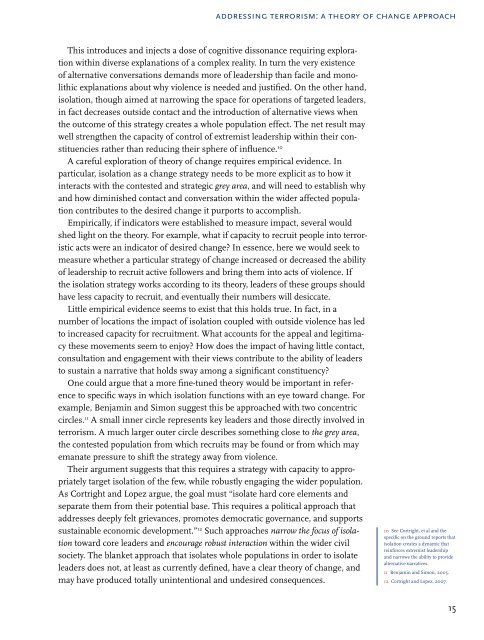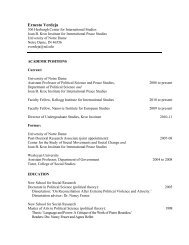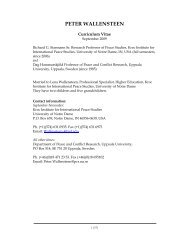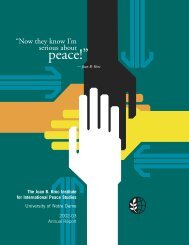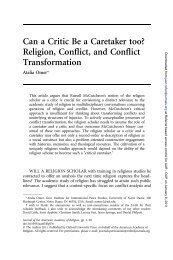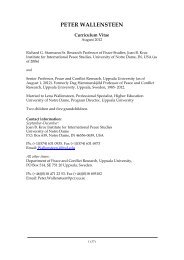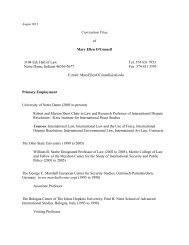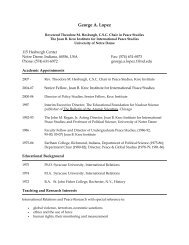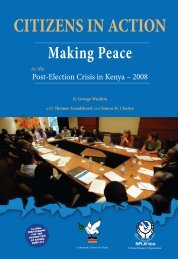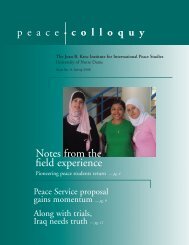Somalia: Creating Space for Fresh Approaches to Peacebuilding
Somalia: Creating Space for Fresh Approaches to Peacebuilding
Somalia: Creating Space for Fresh Approaches to Peacebuilding
Create successful ePaper yourself
Turn your PDF publications into a flip-book with our unique Google optimized e-Paper software.
addressing terrorism: a theory of change approach<br />
This introduces and injects a dose of cognitive dissonance requiring exploration<br />
within diverse explanations of a complex reality. In turn the very existence<br />
of alternative conversations demands more of leadership than facile and monolithic<br />
explanations about why violence is needed and justified. On the other hand,<br />
isolation, though aimed at narrowing the space <strong>for</strong> operations of targeted leaders,<br />
in fact decreases outside contact and the introduction of alternative views when<br />
the outcome of this strategy creates a whole population effect. The net result may<br />
well strengthen the capacity of control of extremist leadership within their constituencies<br />
rather than reducing their sphere of influence. 10<br />
A careful exploration of theory of change requires empirical evidence. In<br />
particular, isolation as a change strategy needs <strong>to</strong> be more explicit as <strong>to</strong> how it<br />
interacts with the contested and strategic grey area, and will need <strong>to</strong> establish why<br />
and how diminished contact and conversation within the wider affected population<br />
contributes <strong>to</strong> the desired change it purports <strong>to</strong> accomplish.<br />
Empirically, if indica<strong>to</strong>rs were established <strong>to</strong> measure impact, several would<br />
shed light on the theory. For example, what if capacity <strong>to</strong> recruit people in<strong>to</strong> terroristic<br />
acts were an indica<strong>to</strong>r of desired change? In essence, here we would seek <strong>to</strong><br />
measure whether a particular strategy of change increased or decreased the ability<br />
of leadership <strong>to</strong> recruit active followers and bring them in<strong>to</strong> acts of violence. If<br />
the isolation strategy works according <strong>to</strong> its theory, leaders of these groups should<br />
have less capacity <strong>to</strong> recruit, and eventually their numbers will desiccate.<br />
Little empirical evidence seems <strong>to</strong> exist that this holds true. In fact, in a<br />
number of locations the impact of isolation coupled with outside violence has led<br />
<strong>to</strong> increased capacity <strong>for</strong> recruitment. What accounts <strong>for</strong> the appeal and legitimacy<br />
these movements seem <strong>to</strong> enjoy? How does the impact of having little contact,<br />
consultation and engagement with their views contribute <strong>to</strong> the ability of leaders<br />
<strong>to</strong> sustain a narrative that holds sway among a significant constituency?<br />
One could argue that a more fine-tuned theory would be important in reference<br />
<strong>to</strong> specific ways in which isolation functions with an eye <strong>to</strong>ward change. For<br />
example, Benjamin and Simon suggest this be approached with two concentric<br />
circles. 11 A small inner circle represents key leaders and those directly involved in<br />
terrorism. A much larger outer circle describes something close <strong>to</strong> the grey area,<br />
the contested population from which recruits may be found or from which may<br />
emanate pressure <strong>to</strong> shift the strategy away from violence.<br />
Their argument suggests that this requires a strategy with capacity <strong>to</strong> appropriately<br />
target isolation of the few, while robustly engaging the wider population.<br />
As Cortright and Lopez argue, the goal must “isolate hard core elements and<br />
separate them from their potential base. This requires a political approach that<br />
addresses deeply felt grievances, promotes democratic governance, and supports<br />
sustainable economic development.” 12 Such approaches narrow the focus of isolation<br />
<strong>to</strong>ward core leaders and encourage robust interaction within the wider civil<br />
society. The blanket approach that isolates whole populations in order <strong>to</strong> isolate<br />
leaders does not, at least as currently defined, have a clear theory of change, and<br />
may have produced <strong>to</strong>tally unintentional and undesired consequences.<br />
10 See Cortright, et al and the<br />
specific on the ground reports that<br />
isolation creates a dynamic that<br />
rein<strong>for</strong>ces extremist leadership<br />
and narrows the ability <strong>to</strong> provide<br />
alternative narratives.<br />
11 Benjamin and Simon, 2005.<br />
12 Cortright and Lopez, 2007.<br />
15


